Thoughts that have tarried in my mind,
and peopled its inner chambers,
The sober children of reason,
or desultory train of fancy,
The fruits I have gathered of memory,
the ripened harvest of my musings.
These give I unto thee.
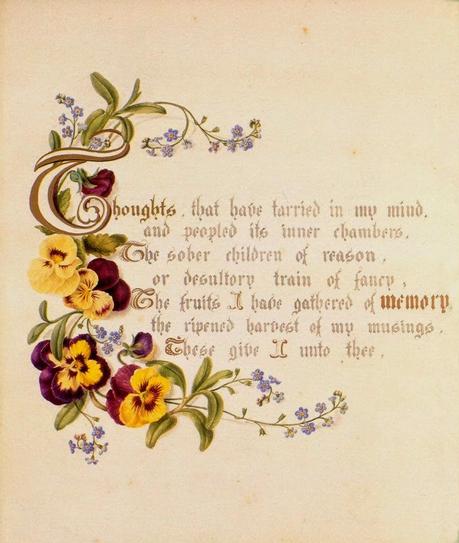
( I pensieri rimasti nel mia mente, / e che hanno popolato le sue più intime stanze, / I figli sobrie della ragione, / o il treno sporadico della fantasia, / I frutti della memoria che ho raccolto, / il raccolto maturo delle mie riflessioni. / Tutto ciò racchiudo in te.)
Riuscite da immaginare la meraviglia che possono aver provato i discendenti di Fanny Robinson nell'aver scoperto, tra ricordi di famiglia, questo suo diario, l'unico decorato che ci si giunto risalente all'epoca vittoriana; si tratta di un vero piccolo capolavoro che combina l'arte del dipingere con quella dello scrivere, poichè Fanny, quando diede avvio a questa raccolta, mise insieme i propri acquerelli botanici - si tratta sempre di tavole che rappresentano piccoli bouquets di fiori, mai di un fiore singolo, ed associandoli ella dimostra di aver piena padronanza del linguaggio dei fiori, come ogni Lady del tempo, del resto - coniugandoli alle più delicate liriche note al tempo, nate dall'animo di Keats, Burne, Wordsworth, etc. e spesso anche dal suo.
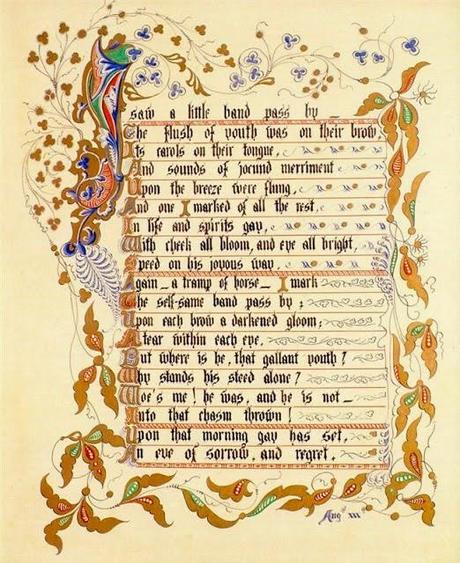
TAVOLA 4
Ogni tavola reca a margine fregi preziosissimi che fanno pensare ai testi antichi copiati durante l'epoca medioevale da pazienti amanuensi, come sicuramente saprete, nel tentativo di preservarli e di trasmetterli ai posteri ( date le minacce rappresentate dalle incursioni barbariche ogni monastero produceva le proprie copie nella speranza che in futuro almeno qualcuna ne sarebbe sopravvissuta, e così è stato, grazie al cielo ! ) o ancora ai Libri delle Ore, testi di preghiera sempre risalenti al medioevo, analogamente decorati; sembra quasi che in ciò abbia voluto ispirarsi all'eclettismo architettonico proprio del periodo vittoriano, che rispolverò con notevole successo, elementi gotici e neogotici, cui ricorre nell'incorniciare le miniature paesistiche con cui spesso correda le sue tavole, a volerci dire sicuramente che ciò che scrive e ciò che ha in mente in quel momento le evocava quel luogo che le era sicuramente familiare.
Poco per volta, a mano a mano che si scorrono le pagine di questo libro, prende corpo la presenza di una figura affettiva della quale l'autrice avverte, e fa avvertire, per via di significati simbolici e metaforici, la mancanza, come se il motivo dominante ne fosse quello di un amore perduto ... probabilmente perduto improvvisamente, una persona alla quale era sicuramente legata in modo profondo.Vi è chi ipotizza che la persona in questione fosse un giovane che frequentava il Magdalen College di Oxford suggerito dagli araldi e dalla riproduzione delle miniature della tavola 19
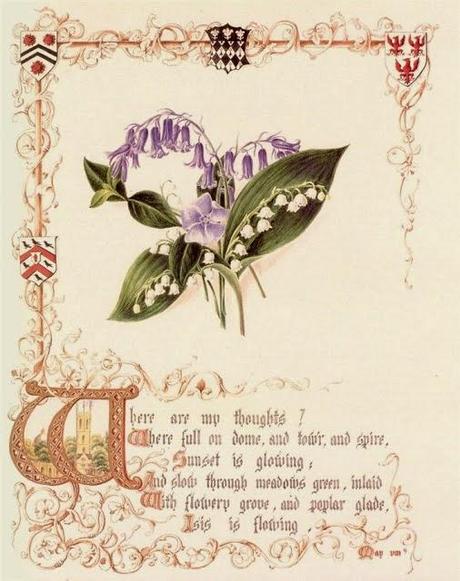
TAVOLA 19
si suppone deceduto di conseguenza ad un incidente di caccia, ma della vita dell'autrice si sa davvero molto poco e di lei non si possiede neppure un'immagine ... a me piace immaginarla così ...
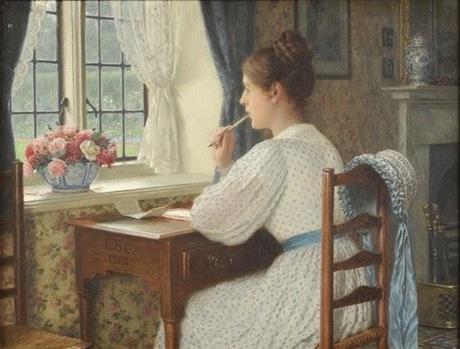
Straying Thoughts
, Edmund Blair Leighton (1852 - 1922)Fanny nacque a Londra nel 1802 in una famiglia distinta e rispettabile e fu educata all'arte ed alla botanica, come si evince da ciò che ci ha lasciato in eredità; sposatasi con William Hubbard Burrell all'età di 36 anni, visse una vita modesta e serena fino a che si spense nel 1872 a Gorlseton nel Norfolk, dove, da che si era maritata, si era trasferita. Per certo si sa che colui cui il Book of Memory è dedicato non era colui che divenne il compagno della sua vita.
La decisione, presa dal pro pro nipote, di rendere noti questi contenuti a fini caritatevoli risale a pochi anni dopo la pubblicazione del prestigioso testo di Edith Holden , The Country Diary of an Edwardian Lady ( ve lo illustrai qui ), ad esso per alcuni aspetti simile, per altri molto differente: se Miss Holden aveva come unico fine quello delle annotazioni diaristiche sulla sua campagna, raccolte nell'arco di un anno solare, associate alle sue notevoli conoscenze in fatto di botanica e competenze nell'arte dell'acquerello, qui il tema è quello di un amore perduto e la sottile malinconia che ne deriva fa da filo conduttore a tutto ciò che in esso è raccolto, pur nell'affinità di conoscenze botaniche e competenze pittoriche ( fermo restando il fatto che separano le due autrici alcune generazioni, appartenendo Fanny Robinson all'epoca vittoriana ed Edith Holden a quella edoardiana ), e la differenza, pur nelle stesse rappresentazioni floreali, egualmente fedeli e dettagliate, è tangibile nel modo in cui vengono rappresentate: l'epoca vittoriana voleva le immagini accuratamente incorniciate e spesso la vergatura delle iniziali di una citazione poetica impegnava per ore, forse ben più che un ricamo, al tempo sicuramente più diffusa come attività presso il gentil sesso.
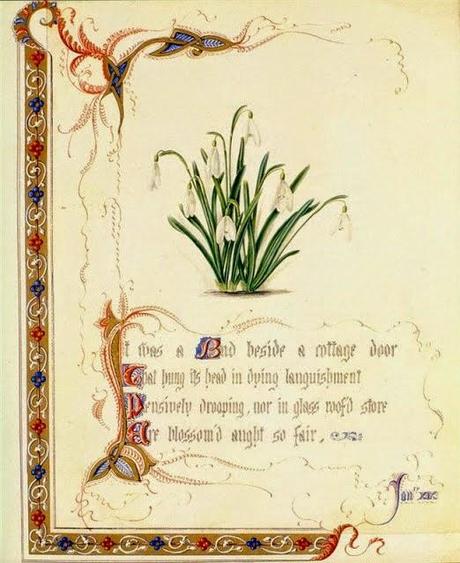
TAVOLA 2
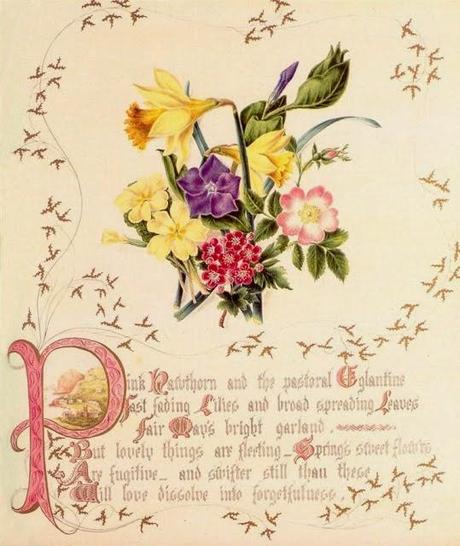
TAVOLA 11
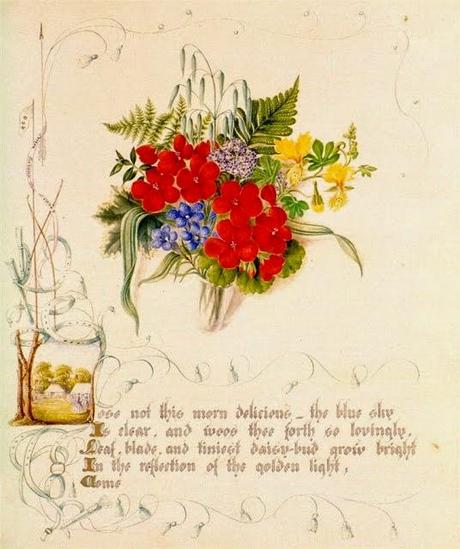
TAVOLA 16
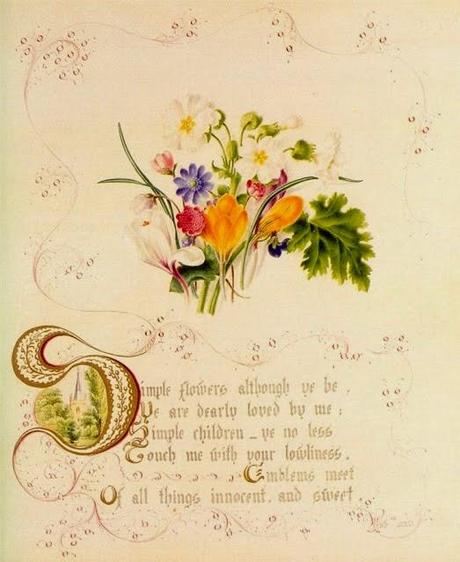
TAVOLA 26
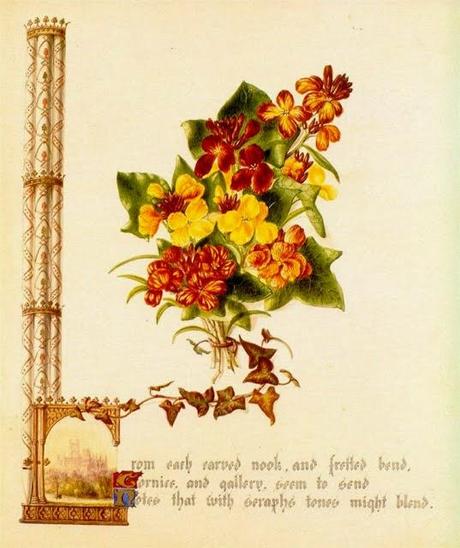
TAVOLA 41
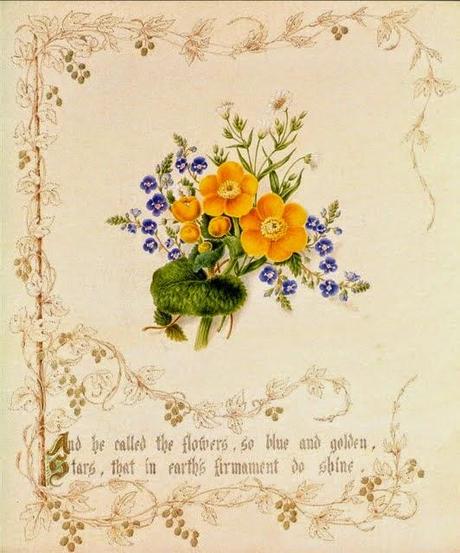
TAVOLA 21
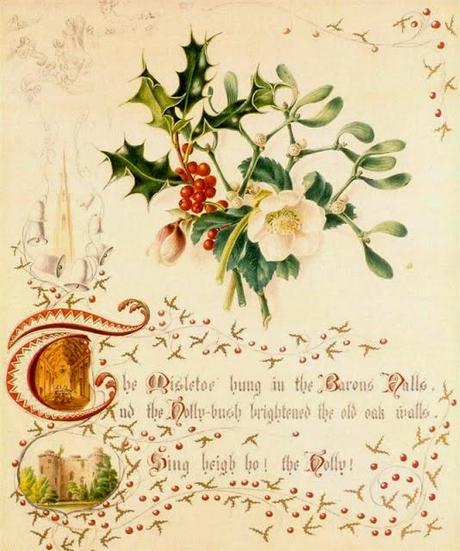
TAVOLA 25
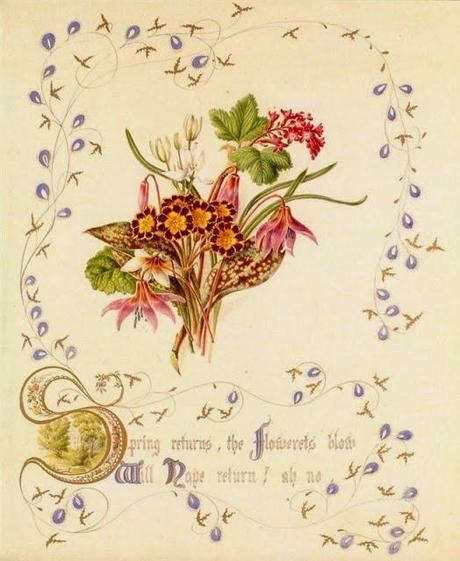
TAVOLA 17
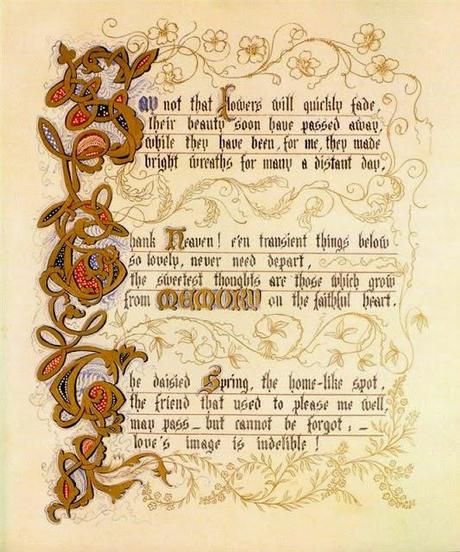
( Non dire che i fiori svaniranno rapidamente /e che la loro bellezza sarà presto qualcosa di trascorso / per ciò che sono stati, per me, ed hanno intessuto / ghirlande luminose in un giorno tanto lontano. Grazie al Cielo! Le cose che appartengono al nostro mondo /e che sono così piacevoli, non dovrebbero mai svanire / i pensieri più dolci sono quelli che crescono / nel RICORDO di un cuore fedele.La primavera fiorita di margherite, il luogo familiare, / l'amico che era solito compiacermi, / tutto può finire - ma non può essere dimenticato: - / l'immagine dell'amore è indelebile.)
Anche se sono stati d'animo quali la nostalgia, il rimpianto per giorni trascorsi e che non potranno più tornare, il ricordo di una gioia legata ad un tempo che non è più e la mestizia per il negato coronamento di un sogno ( Rechi il tuo fiore luminoso quando l'estate è trascorsa, / come una nuova speranza al cuore di una persona desolata. 1 ; La primavera torna, i fiori sbocciano / Tornerà al speranza? ah, no 2 ; I fiori sono le gemme che i bambini amano, / ed ancora gli uomini si deliziano al guardarli, / E mi portano mille ricordi / di tempi trascorsi ! 3 ), questo libro, in virtù dello stile con cui è acquerellato, della scelta dei fiori accostati in base al significato simbolico attribuito loro dal linguaggio dei fiori, delle liriche che vi figurano, trasmette una gioia profonda e sfogliarlo rinfranca lo spirito, credetemi !
Un saluto come sempre colmo di affetto e gratitudine a chi mi segue con dedizione ed interesse, auguro ogni bene a tutti voi.
A presto ♥
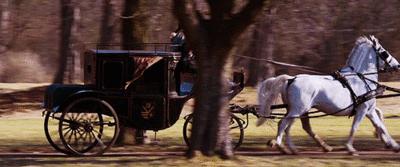

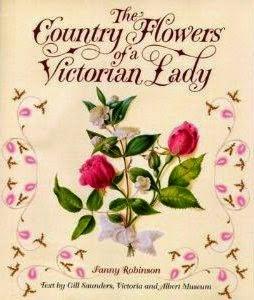
Victorian Lady, Text by Jill Saunders -
Victoria and Albert Museum,
HarperCollins Publishers, US.
Citazioni:
1 -
Fanny Robinson, The Country Flowers of a Victorian Lady, op.cit., pag. 842 - Ibid., pag. 423 - Ibid., pag. 77

- picture 1
With this first plate begins The Book of Memory, as the author Fanny Robinson called it, recently reissued with the titleThe Country Flowers of a Victorian Lady, dating, think, to 1840.
Can you imagine the wonder that may have felt the descendants of Fanny Robinson having found this diary among family memories, the only one decorated 'memoir' we have inherited dating back to the Victorian era; it's a true masterpiece that combines the art of painting with that of writing, as Fanny, when she gave start to this collection, put together her botanical watercolors - they are always plates representing small bouquets of flowers, never a single flower, and putting them together she proves to have full mastery of the language of flowers, as each Victorian Lady after all - combining them with the most delicate poems known at the time, born from the soul of Keats, Burne, Wordsworth, and often also from hers.
- picture 2 - PLATE 4
Each plate shows precious ornaments at his margin that evoke the ancient texts copied during the Middle Ages from patients scribes, as you surely know, attempting to preserve and to transmit them to posterity (given the threat of barbarian raids every monastery produced its own copies in the hope that in the future at least some of them would have survived, and so it was, thank goodness!), or the Books of Hours, prayer texts also dating back to the Middle Ages, similarly decorated; it seems that in her decoration she wanted to be inspired by the eclectic architecture of the Victorian period, that reintroduced, with considerable success, Gothic and neo-Gothic elements, which she resort to framing the little landscapes thumbnails which often accompanies her botanical watercolours and verses, to want definitely to tell us that, what she writes and what she has in her mind in that moment, evokes in her soul that place that was certainly familiar to her.
Little by little, as you gradually scroll through the pages of this book, it takes body the presence of an affective figure of which the author feels the absence, as the symbolic and metaphorical meanings tell us, a lack, as if the dominant reason it was that of a lost love ... probably lost suddenly, a person to whom she was certainly linked in a profound way.There are those who assume that the person in question was a young man who attended the Magdalen College, Oxford, suggested by the heralds and the thumbnail of the table 19
- picture 3 - PLATE 19
supposedly died as a result of a hunting accident, but about the author's life we do know very little and of her we don't have even a picture ... I like to imagine her so ...
- picture 4 - Straying Thoughts, Edmund Blair Leighton (1852 - 1922)
Fanny was born in London in 1802 into a genteel family and was educated to art and to botany, as we may cleary understand from what we've inherited; she got married with William Hubbard Burrell at the age of 36, lived a modest and serene life until she died in 1872 in Gorleston, Norfolk, where, since she was married, had moved. We know for sure that the person to whom the Book of Memory is dedicated wasn't the one who became her life's companion.
The decision, taken by the pro pro nephew, to make known these contents with charitable purposes dates back to a few years after the publication of Edith Holden's prestigious text The Country Diary of an Edwardian Lady ( I talked you about here ), and it is, in some ways, to it quite similar, in other very different: if Miss Holden had as sole purpose that of annotating on her diary what she saw in her countryside over a calendar year, combining all this with her considerable knowledge about botany and skills in the art of watercolor, the theme here is that of a lost love and the subtle melancholy that derives from it is the underlying theme to everything is collected here, in spite of the affinity of botanical knowledge and skills of painting ( we have also to remember that a few generations separate the two authors, as Fanny Robinson belonged to the Victorian era and Edith Holden to the Edwardian one), and the difference, even in the same floral representations, equally faithful and detailed, is tangible in the way they are represented: the Victorian era wanted the images carefully framed and, as you can see, the initials of a poetic quotation could keep busy for several hours, maybe more than if they would have been embroidered, also if certainly embroidery was much more widespread as activity of the fairer sex.
- picture 5 - PLATE 2
I think I don't need to add even a little more, I leave you with the photographs of some of the pages of this invaluable text that for a few days is part of the collection in my library - and I say it with great pride !
- picture 6 - PLATE 11- picture 7 - PLATE 16- picture 8 - PLATE 26- picture 9 - PLATE 41- picture 10 - PLATE 21- picture 11 - PLATE 25- picture 12 - PLATE 17- picture 13 - PLATE 42
Even though they are feelings such as the melancholy, the nostalgia for the days spent and that will come back no more, the sadness for a lost joy, the sadness for the denied fulfillment of a dream ( Ye bring your bright blossom when Summer is gone, / Like new hope to the heart of a desolate one 1 ; Spring returns, the flowers blow. / Will hope return ? ah, no. 2 ; Flowers are the gems that children love, / Yet men delight to see, / And they bring a thousand memories / Of by-gone days to me ! 3 ), this book, by virtue of the style with which it has been painted, the selection of the flowers combined according to the symbolic meaning ascribed to them by the language of flowers and the lyrics therein, conveys a deep joy and heartens one's mind, believe me !
A greeting, as always full of affection and gratitude, to those who follow me with dedication and interest, I wish much love to all of you.
See you soon ♥
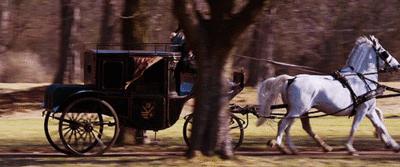

Quotations:
1 -
Fanny Robinson, The Country Flowers of a Victorian Lady, op.cit., page 842 - Ibid., page 423 - Ibid., page 77







